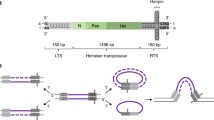Abstract
The region immediately 3′ of histidine-3 has been cloned and sequenced from two laboratory strains of the ascomycete fungus Neurospora crassa; St Lawrence 74A and Lindegren, which have different derivations from wild collections. Amongst the differences distinguishing these sequences are insertions ranging in size from 20 to 101 by present only in St Lawrence. The largest of these is flanked by a 3 by direct repeat, has terminal inverted repeats (TIR) and shares features with several known transposable elements. At 98 bp, it may be the smallest transposable element yet found in eukaryotes. There are multiple copies of the TIR in the Neurospora genome, similar but not identical to the one sequenced. PCR amplification of Neurospora genomic DNA, using 26 by of the TIR as a single primer, gave products of discrete sizes ranging from 100 by to about 1.3 kb, suggesting that the element isolated (Guest) may be a deletion derivative of a family of larger transposable elements. Guest appears to be the first transposable element reported in fungi that is not a retrotransposon.
Similar content being viewed by others
References
Angel T, Austin B, Catcheside DG (1970) Regulation of recombination at the his-3 locus in Neurospora crassa. Aust J Biol Sci 23:1229–1240
Barratt RW (1962) Origin of important stocks of N. crassa. Neurospora Newslett 2:24–25
Barratt RW, Garnjobst L (1949) Genetics of a colonial microconidiating mutant strain of Neurospora crassa. Genetics 34:351–369
Bureau TE, Wessler SR (1992) Tourist: a large family of small inverted repeat elements frequently associated with maize genes. Plant Cell 4:1283–1294
Catcheside DEA (1970) Control of recombination within the nitrate-2 locus of Neurospora crassa: an unlinked dominant gene which reduces prototroph yields. Aust J Biol Sci 23:855–865
Catcheside DG, Angel, T (1974) A histidine-3 mutant, in Neurospora crassa, due to an interchange. Aust J Biol Sci 27:219–229
Gierl A, Saedler H (1992) Plant-transposable elements and gene tagging. Plant Mol Biol 19:39–49
Grandbastien MA (1992) Retroelements in higher plants. Trends Genet 8:103–108
Hermann A, Schultz W, Hahlbrock K (1988) Two alleles of the single-copy chalcone synthase gene in parsley differ by a transposon-like element. Mol Gen Genet 212:93–98
Kinsey JA (1993) Transnuclear retrotransposition of the Tad element in Neurospora crassa. Proc Natl Acad Sci USA 90:9384–9387
Kinsey JA, Helber J (1989) Isolation of a transposable element from Neurospora crassa. Proc Natl Acad Sci USA 86:1929–1933
Köster-Töpfer M, Frommer WB, Rocha-Sosa M, Willmitzer L (1990) Presence of a transposon-like element in the promoter region of an inactive patatin gene in Solanum tuberosum L. Plant Mol Biol 14:239–247
Morgan GT, Middleton KM (1990) Short interspersed repeats from Xenopus that contain multiple octamer motifs are related to known transposable elements. Nucleic Acids Res 18:5781–5786
Orbach MJ (1994) A cosmid with a Hy(R) marker for fungal library construction and screening. Gene 150:159–162
Saiki RK, Gelfand DH, Stoffel S, Scharf SJ, Higuchi R, Horn GT, Mullis KB, Erlich HA (1988) Primer-directed enzymatic amplification of DNA with a thermostable DNA polymerase. Science 239:487–491
Schectman MG (1986) A moderate scale DNA preparation for Neurospora. Neurospora Newslett 32:16–17
Schectman MG (1987) Isolation of telomere DNA from Neurospora crassa. Mol Cell Biol 7:3168–3177
Schectman MG (1990) Characterization of telomere DNA from Neurospora crassa. Gene 88:159–165
Selker EU (1990) Premeiotic instability of repeated sequences in Neurospora crassa. Annu Rev Genet 24:579–613
Vollmer SJ, Yanofsky C (1986) Efficient cloning of genes of Neurospora crassa. Proc Nat Acad Sci USA 83:4869–4873
Yeadon PJ, Catcheside DEA (1995) The chromosomal region which includes the recombinator cog in Neurospora crassa is highly polymorphic. Current Genetics, in press
Author information
Authors and Affiliations
Additional information
Communicated by D. J. Finnegan
Rights and permissions
About this article
Cite this article
Yeadon, P.J., Catcheside, D.E.A. Guest: a 98 bp inverted repeat transposable element in Neurospora crassa. Molec. Gen. Genet. 247, 105–109 (1995). https://doi.org/10.1007/BF00425826
Received:
Accepted:
Published:
Issue Date:
DOI: https://doi.org/10.1007/BF00425826




